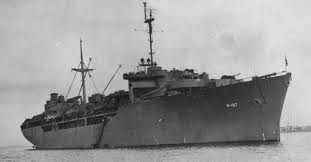Most amphibious warships constructed before the late 1970s contained amianto in numerous components. Anyone who worked aboard or around these vessels is at a heightened risk of developing asbestos illnesses like mesotelioma. Benefits y compensación are available to veteranos with mesothelioma.
If you or a loved one have mesothelioma, asbestos-related lung cancer, or asbestosis, you may be eligible for a large amount of compensation. We invite you to fill out our form today for a free Financial Compensation Packet, filled with information about experienced mesothelioma lawyers in your area, how to get paid in 90 days, how to file an asbestos trust fund afirmar, and much more.


Paquete de compensación financiera GRATUITO
- Información sobre despachos de abogados que recuperarán su INDEMNIZACIÓN MÁS ALTA
- Aprenda cómo cobrar en 90 días
- Solicite su parte de $30 mil millones en fondos fiduciarios

About Amphibious Warships
Amphibious ships are vessels that can go between land and sea. They provide transport and support and cover ground troops. The design of amphibious ships is based on aircraft carriers. Like carriers, they often have flight decks to use helicopters for landing troops.
Today’s Marina de los EE. UU. includes several amphibious ship classifications:
- Amphibious Command Ships (LCC). The LCC ships have advanced technologies for collecting intelligence and for communications.
- Dock Landing Ships (LSD). Dock landing ships provide support. They have docking areas for smaller vessels and the most aircraft landing capability of any class.
- San Antonio Class (LPD). San Antonio ships are landing platform docks that provide transport.
- Tarawa Class (LHA). LHA ships (landing helicopter assault) are general-purpose vessels that can carry up to 30 helicopters.
- Wasp Class (LHD). These ships are landing helicopter docks. They carry more aircraft than the LHAs and are nearly as large as aircraft carriers. They support special operations and humanitarian operations.
Why Did Amphibious Warships Contain Asbestos?
Like all vessels in the U.S. Navy, amphibious warships were constructed with hundreds of asbestos components. The Navy built ships with asbestos from approximately the 1930s through the 1970s.
The Navy used asbestos extensively for its insulating properties. Asbestos is very effective at insulating against heat and protecting against fire, important qualities for materials on ships.
The History of Amphibious Warships
Amphibious Warships were created in the late 1800s around the Battle of Pisagua. The military needed an effective way to carry its troops and cargo during amphibious tasks and operations. Here are some additional facts about these vital Navy ships:
- The Chilean government created the first amphibious warship.
- When World War I started, the U.S. military began experimenting with constructing amphibious warships. By 1933, the U.S. Marines and la Marina de los EE. UU. set up the Fleet Marine Force (FMF), a special forces operation that designed and constructed amphibious warships and Naval fleets.
- Shortly after, the FMF began constructing vessels known as “Higgins Boats,” large vessels with extra-wide ramps that could carry over 30 troops, a vehicle, and cargo.
- By World War II, the military became interested in creating better vessels to hold more ships and cargo. At the beginning of the war, the military had no amphibious assault ships and looked to the British military for ideas.
- The British Royal Navy began creating numerous amphibious warships, such as the LCT Mark 1, LCT Mark 2, and the LCT Mark 3. Each vessel built could hold additional troops and cargo.
- The LCT Mark 4 was created shortly after but was constructed slightly smaller than the previous versions to help cross-channel operations easier.
- The U.S. military created the LCT Mark 5, which could hold 150 tons of cargo and hundreds of troops.
Numerous designs followed, leading to many new amphibious warships, including:
- General-purpose assault ships
- Multi-purpose assault ships
- Force Flagships
- Command ships
- Attack transports
- High-speed transports
- Cargo Ships
Where Was Asbestos Used on Amphibious Warships?
According to military documents and memos, over 250 different asbestos-containing products were used when making military vessels. Many of these products were also used when constructing and repairing amphibious warships.
Asbestos-containing products on amphibious were found in:
- Pipes
- Juntas
- Aislamiento
- Cables
- Materiales de embalaje
- Calderas
- Decks
- Ceilings
- Tubes
- válvulas
Who Is at Risk for Mesothelioma from Asbestos on Amphibious Warships?
Asbestos exposure is the only known cause of mesothelioma. Anyone expuesto al amianto could develop this type of cancer and other illnesses, including lung cancer.
Veteranos, in particular, are at the highest risk of developing an asbestos-related disease, such as malignant mesothelioma or asbestos-related lung cancer.
Many veterans who helped build or repair amphibious warships didn’t wear the proper gear to help protect them from asbestos fibers. For many years, they were never warned of the risks involved in being around asbestos.
Anyone serving on Navy ships during the years of asbestos use could have been exposed, but some roles put service members at greater risk:
- Trabajadores de la sala de calderas
- Trabajadores de la sala de máquinas
- Instaladores o reparadores de aislamientos
- bomberos
- Maquinistas
- Artilleros
- Mecánica
Which Amphibious Warships Contained Asbestos?
These are just some of the U.S. Navy amphibious warships known to have contained asbestos and their year of commissioning:
- USS Anchorage, 1969
- USS Blue Ridge, 1970
- USS Casa Grande, 1944
- USS Catamount, 1944
- USS Charleston, 1968
- USS Cleveland, 1967
- USS Comstock, 1945
- USS Denver, 1968
- USS Donner, 1945
- USS Durham, 1969
- USS El Paso, 1970
- USS Fort Mandon, 1945
- USS Francis Marion, 1960
- USS Goodhue, 1944
- USS Inchon, 1970
- USS Iwo Jima, 1961
- USS Kleinsmith, 1945
- USS Lenoir, 1944
- USS Mobile, 1969
- USS Mount McKinley, 1944
- USS Nashville, 1970
- USS New Hanover, 1944
- USS Newman, 1943
- USS Okinawa, 1962
- USS Rockbridge, 1944
- USS Rushmore, 1944
- USS Saipan, 1977
- USS San Marco, 1945
- USS Shadwell, 1944
- USS Spiegel Grove, 1956
- USS St. Louis, 1969
- USS Starr, 1944
- USS Stokes, 1944
- USS Tate, 1944
- USS Tortuga, 1945
- USS Whetstone, 1946
Do Amphibious Ships Still Have Asbestos?
The Navy stopped constructing ships with asbestos in the late 1970s. Around that time, it also began a program to remove asbestos from ships. Unfortunately, the Navy has not removed all asbestos from all ships.
Many Navy vessels, including amphibious ships, still contain some asbestos components. These asbestos materials put the men and women currently serving in the Navy at risk of exposure. The asbestos materials should be safe and contained, but the risk is always there.
Benefits and Compensation for Navy Veterans with Mesothelioma
If you served on an amphibious ship or any other Navy vessel and now have mesothelioma, you have options for seeking compensation.
V.A. Benefits
The U.S. Department of Veterans Affairs (V.A.) offers benefits to veterans who have become ill or injured during their time in the service. The Virginia also has benefits for qualifying dependents.
An important benefit for veterans with mesothelioma is monthly disability compensation. The VA gives mesothelioma a disability rating of 100%. Veteranos with this diagnosis may be eligible for maximum monthly benefits.
Also crucial to veterans with mesothelioma is medical care. Because mesothelioma is more common in veterans than the general population, several VA facilities have mesothelioma specialists on staff or have access to specialists at local hospitals.
Mesothelioma Lawsuit
Veterans cannot sue the military or federal government, but there is another option. Veterans can sue the asbestos companies that supplied the military. An asbestos lawsuit can lead to a substantial settlement, which does not affect the veteran’s V.A. benefits.
Reclamación al Fondo Fiduciario del Amianto
Many asbestos companies went bankrupt and can no longer be sued. These companies set up fondos fiduciarios to compensate claimants in the future. Veterans may be eligible to make claims with one or more of these funds.
If you served on an amphibious Navy ship and now have an asbestos illness, talk to an experienced mesothelioma or bufete de abogados especializado en amianto. These legal experts can review your options and help you get the compensation you need.
Additional Help and Information for Veterans and Mesothelioma Victims
Don’t forget to fill out our form to get our free Financial Compensation Packet, filled with information on the experienced asbestos and mesothelioma attorneys in your area. Keep in mind that if you’ve been diagnosed with mesothelioma, asbestos-related lung cancer, or asbestosis, you may be eligible for considerable compensation to cover medical expenses, pain, lost wages, anguish, and much more. For additional assistance or if you have any pertinent questions, contact us toll-free at 800-793-4540.

Pablo Danziger
Revisor y editorPaul Danziger creció en Houston, Texas, y se licenció en Derecho en la Facultad de Derecho de la Universidad Northwestern en Chicago. Durante más de 25 años, se ha dedicado a representar a víctimas de mesotelioma y a otras personas afectadas por la exposición al asbesto. Paul y su bufete han representado a miles de personas diagnosticadas con mesotelioma, asbestosis y cáncer de pulmón, obteniendo indemnizaciones significativas para los clientes lesionados. Cada cliente es fundamental para Paul y atenderá todas las llamadas de quienes deseen hablar con él. Paul y su bufete se encargan de casos de mesotelioma en todo Estados Unidos.
Conéctese con el abogado especializado en mesotelioma Paul Danziger
Referencias
- Potts, J.R. (2017, July 19). USS Okinawa (LPH-3). Military Factory.
Recuperado de: http://www.militaryfactory.com/ships/detail.asp?ship_id=USS-Okinawa-LPH3 - Payne, A. (1971). British Landing Craft of World War II. Naval Historical Society of Australia.
Recuperado de: https://www.navyhistory.org.au/british-landing-craft-of-world-war-ii/ - Ibiblio. (2006, May 25). Ships of the U.S. Navy, 1940-1945, Small Landing Craft.
Recuperado de: http://www.ibiblio.org/hyperwar/USN/ships/ships-slc.html
